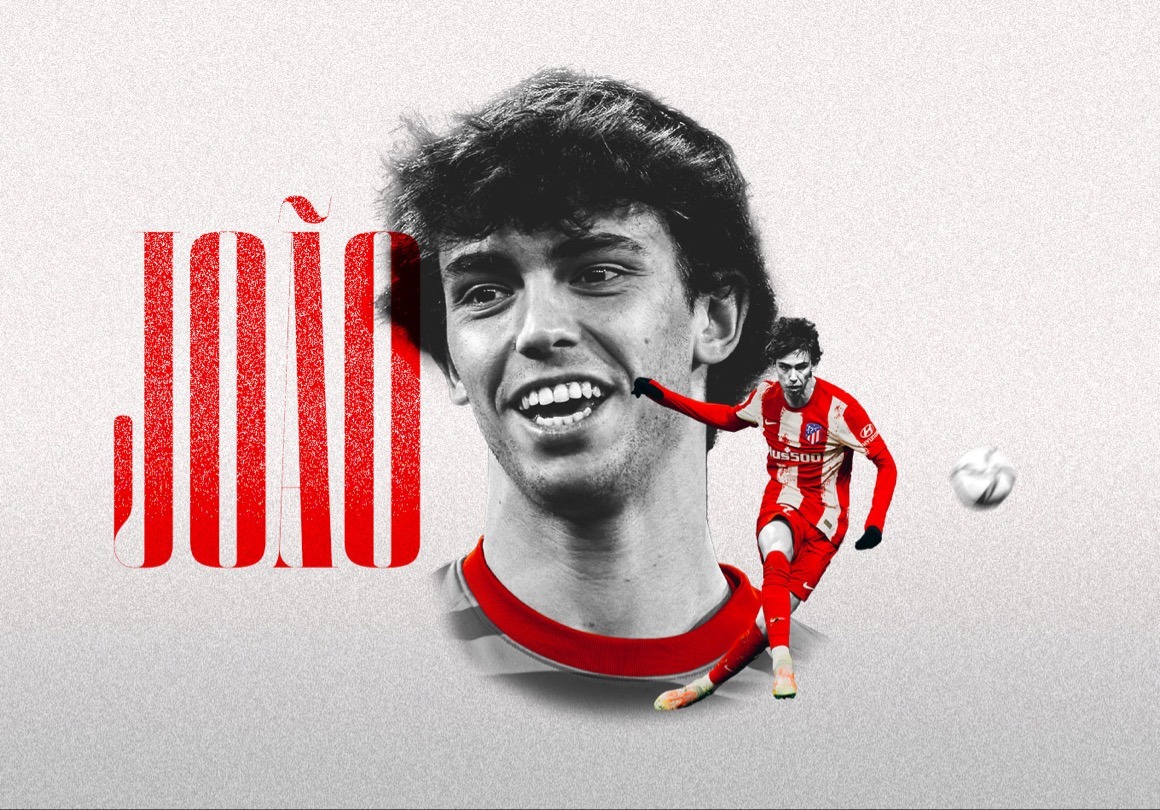Between 2011 and 2019, Atlético Madrid had made up considerable ground at the top of European football. Under Diego Simeone, what had long been a ‘big two’ in Spain was gradually re-built as a ‘big three’, while the 2013-14 season in which Atlético won La Liga and were minutes away from winning the Champions League confirmed it beyond all doubt. In that moment the Colchoneros knew they were tethered to Real Madrid and Barcelona, following their every move and in position to make a defining move within the domestic hierarchy, as well as Europe.
On the pitch, Diego Simeone’s side could compete with anyone on any given day. But as the years stacked up and Atlético’s ascent began to flatten out, the famous ‘partido a partido’ (‘game by game’) approach led by their manager became less and less reliable as an antidote to their talent disparity over the course of a 50-plus game season. Without any plans to part ways with Simeone – the man who gave them everything and still guaranteed a high level of competitiveness – the only possible solution would have to be found in the transfer market.
On 3rd July 2019, they stepped out of the shadow of European football’s superpowers and showed they would no longer settle for the ‘best of the rest’ when the game’s most coveted talent came to auction.
“Some people are born with an innate talent that they show from a young age. Writers, painters, sculptors, sportsmen…”, said club President Enrique Cerezo. “The word that best describes João is ‘talent’. At 19, he has a great career ahead of him and we’re proud that he chose the Red & White colours. João, welcome to Atlético de Madrid.”
In moving on from Antoine Griezmann – who had left for Barcelona, citing a desire to learn a new style of play and new philosophies rather than to win more trophies – Atlético had pushed all of their chips in on João Félix; the Portuguese teenager they assumed to be a headline star of the sport in waiting. It was a direct response to an era in which they had regularly been in the mix, but all too often burned by the individual difference-making of Lionel Messi with Barcelona and Cristiano Ronaldo with Real Madrid. They had never been close to owning an individual of such gravity, but in Félix they could envision the Ballon d’Or-level talent of the future they had never had.
At a reported €126 million, Madrid newspaper Diario AS had Félix as the third most expensive player ever. Rival paper Marca later had him as the fourth most, while the American Business magazine Forbes had him in fifth spot. The figures were so overwhelming for a teenage footballer that nobody seemed to know for sure. What we did know was that João Félix belonged to the hundred million club: the cadre of trophy-guaranteeing, merchandise-shifting stars of the planet’s most popular sport. And that would make him different.
Two-and-a-half years later Atlético’s investment is hurtling towards a tipping point, although it’s not necessarily because Félix isn’t the talent they imagined. In fact, it’s an exercise without an answer to weigh the proportion of each obstacle he has faced at the club. Price tag, expectation, youth, a new environment and frequent injury problems are all contributing factors in his uneasy marriage with Atlético. But the dark cloud that hangs over Félix and the club – or more specifically, Diego Simeone – is a general incompatibility between player and coach in which common ground has continued to escape them.
The timeline of Félix’s arrival in 2019 tracks with Atlético’s edge towards the most notable stylistic change in the Simeone era. In 2020-21, they averaged over 50% possession for the first time in a league season (52%) under the Argentine, while their per game average of 225 passes in their own half was a 47% increase from their title-winning season in 2013-14.
After using a 4-4-2 system almost exclusively between 2011-12 and 2019-20, Atlético began to introduce a variety of line-ups based around a 3-5-2, with the main aim being to have more tactical flexibility without losing their defensive strength. As the quality of their squad was improving – and particularly after the €126 million signing of Félix – Simeone had acted in accordance with the mounting pressure from all sides to advance their style of play. There was no going back to the full essence of what they used to be. The only question was how far they would go away from it.
Atlético did find temporary success amidst their changing form – they won the title in 2020-21, for a second time under Simeone. Without taking too much credit away, however, their expected goal difference per game was only the fifth highest in La Liga (0.36), and was accompanied by both Real Madrid and Barcelona being in varying states of limbo. Atlético clung to an evaporating lead down the stretch of the season, but eventually squeezed home on the back of a 21-goal season from the vengeful, Barcelona cast-off Luis Suárez; Marcos Llorente scoring an improbable 12 times from an xG of 3.4, and Jan Oblak preventing a league-best 8.6 goals according to the Opta expected goals on target metric. It was a fine recipe for a single-season home run.
From December onwards, however, Félix had become a peripheral figure and in between injury delays, a consequence of their tunnel vision in pursuit of a title. The problem for Atlético – who currently trail leaders Real Madrid by 14 points in their title defence – has been giving continuity to the progressive steps they began to make in late 2020, which had already begun to fracture as they dug in for the title.
After their initial success in the first half of the 2020-21 season, Simeone has continually flip-flopped between the new and the old, showing a reticence to fully commit to his growing creative options. It has plunged Atlético back into a state of conflicted identity, as they are now neither the defensive force they once were, nor do they empower their considerable attacking options. None have felt the effects of this identity struggle more than João Félix.
Compare the way in which Atlético have reacted to going ahead this season with other clubs across the big five European leagues. Their average possession drops from 54% when level down to 44% when leading, ranking them 43rd out of 98 teams when ahead. This is slightly lower than their average from the 2013-14 season when they first scrapped their way to the title.
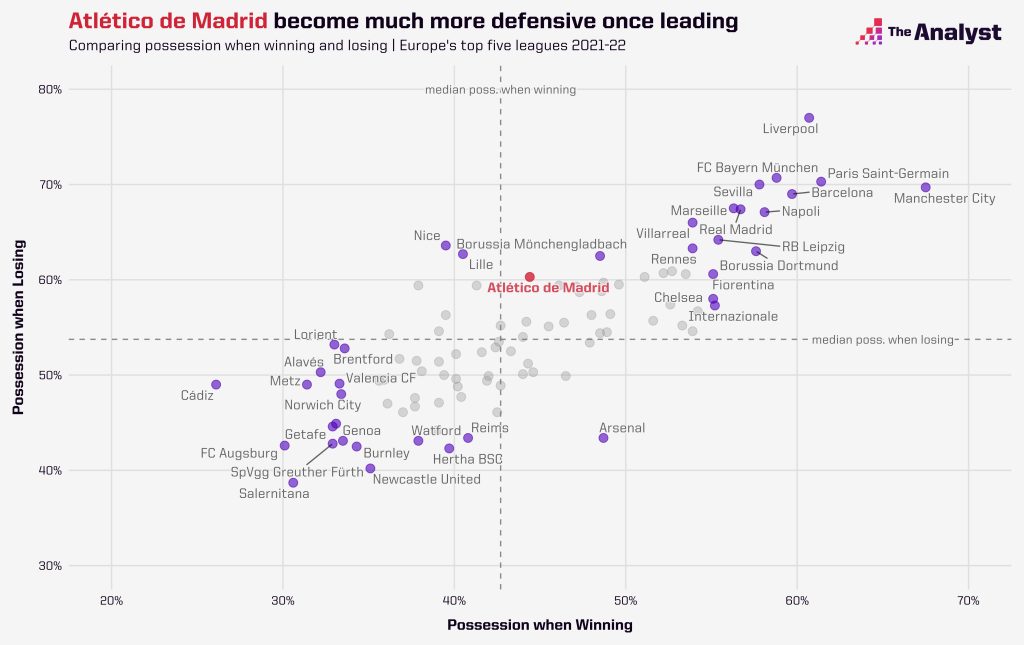
With regard to Félix, Atlético’s priority of protecting themselves through defensive shape leads to extended spells without contact with the ball and a ceding of territory which forces him back into his own half. It also narrows Félix’s input in Atlético’s attack, as they look for transitions through the likes of Yannick Carrasco more than slow-cooking positional advantages. And given their struggles in breaking defences down, Simeone isn’t inclined to pass up room to run into.
Where the likes of Manchester City actually have a higher rate of possession when leading than when level – and teams from various tiers below like Napoli and Borussia Dortmund only have minimal reductions – Atlético still retreat into protection mode the same way they did in the early years of Simeone’s reign. While this approach when leading is only a segment of the game, their reflex tells us a lot about the over-arching approach. Atlético have one of the 10 most expensive squads in European football according to the CIES Football Observatory, including one of the most expensive footballers ever, but they are still wired to survive above all.
This breeds a conflict between Félix – the expressive star who craves the ball at his feet and a surrounding cast of participants – and Simeone, the manager who craves an XI of like-minded competitors who reinforce a menacing collective in place of free-flowing attacking conditions. By this stage, it’s quite clear that Simeone is not going to be able to re-wire his game in the same way he did with Antoine Griezmann in the mid-2010’s.
While Félix has largely been played as part of a front two in his Atlético career, he is naturally in between that of a striker and a midfielder. He told El Español in 2021 that his first reference as a player was Kaká, while in an interview with the Players Tribune he explicitly stated: “I’m not a goalscorer” when recalling details from a game between Benfica and Sporting CP some years earlier.
The ideal version of Félix should be that of a prolific playmaker who can also find his way into scoring opportunities through intelligent play in the final third, rather than that of a standard ‘striker in a front two’ who looks to work off the creation around him.
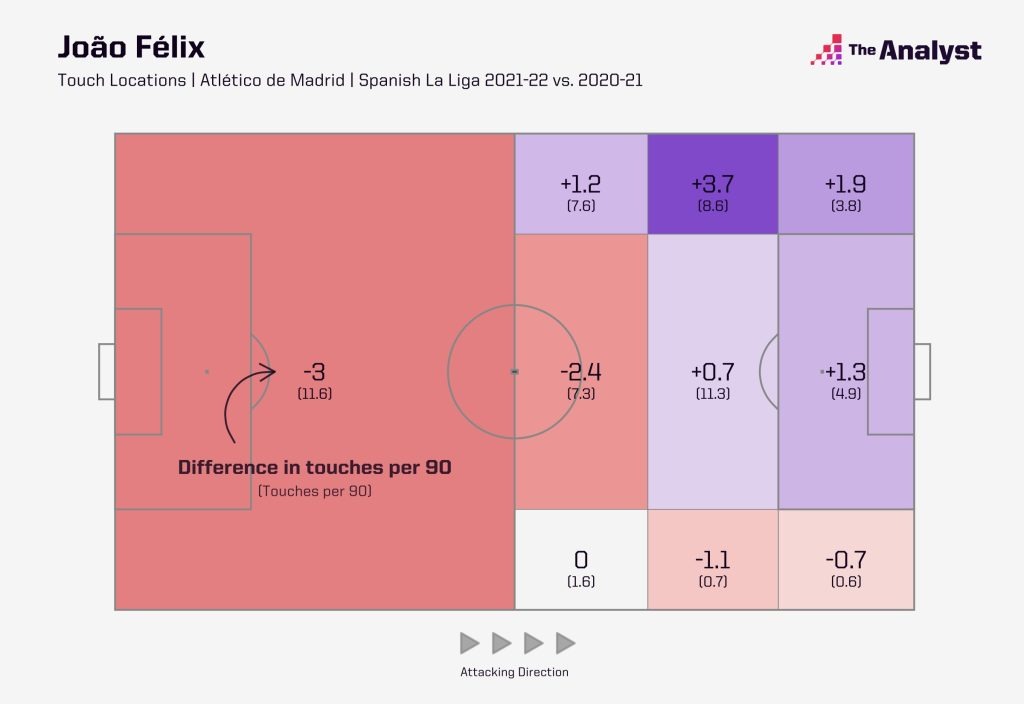
In Atlético’s current iteration, Félix finds most of his touches by dropping out of the front line and into the left channel just inside the opposition half. This is a safe zone by where his team don’t have to be particularly precise in finding him – as opposed to between the lines in the final third – and where Félix vacating the ‘front two’ usually means defenders aren’t willing to be dragged up the field to pursue him.
The 22-year-old can find touches in this space but it’s more often out of necessity, given that he can’t bank on a steady flow of passes into him in more advanced positions. Félix is receiving an average of 10.2 passes in the final third per 90 in La Liga this season, which ranks him seventh among Atlético players with at least 500 minutes played, and considerably behind other top creative players across the big five European leagues.
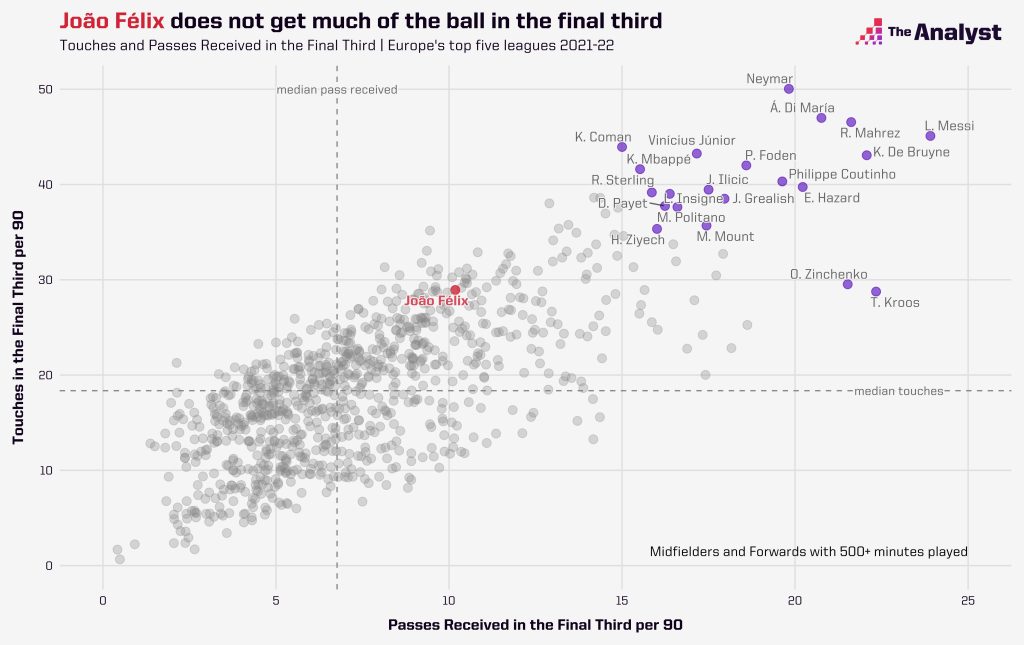
His modest service at the sharp end of the pitch – at least, by the standards of creative players at other top clubs – is confounded by Atlético not sustaining their attacks consistently, relative to their attacking talent. Along with an average possession rate of 53%, they rank 14th out of 20 teams in La Liga this season for PPDA (11.5) – a measure of how disruptive teams are against opposition possession – highlighting their preference to retreat into a defensive shape rather than hunt the ball as a team.
By not launching counter-pressing efforts or controlling games with possession, the game can often drift away from Félix and affect his sense of involvement. In other words, the quickest way to diminish his effect. Even with one of the best attacking cores in Europe, the nature of Simeone’s side is to keep the back door closed rather than commit to sustaining attacking initiative.
Despite the less-than-ideal environment for a touch-happy creative player, Félix has still served up some world-class performances to snap us out of his Atlético lull. Take his showing against Barcelona earlier in the season, for example. He received a total of 22 passes in the game, of which only two were in the final third. He didn’t score a goal. And yet he was still the most decisive player on the pitch, laying on three passes in the first half that tore Barcelona open beyond repair. His turn that almost shook Ronald Araújo out of his boots in the build-up to the opening goal, especially, was a reminder that Félix’s talent is determining on the biggest of stages.
If there’s one group who don’t take him for granted, it’s Atlético’s opposition: Félix is statistically the most fouled player in the big five European leagues this season. His rate of 4.8 fouls won per 90 is the highest of any player by a sizeable margin, among those with at least 500 minutes played. As a proportion within his team, Félix accounts for 29% of fouls suffered on Atlético players when he’s on the pitch – by comparison, the highest such share in Europe’s big five leagues belongs to Neymar, who accounts for 32% of all fouls won by PSG players when he is on the pitch.
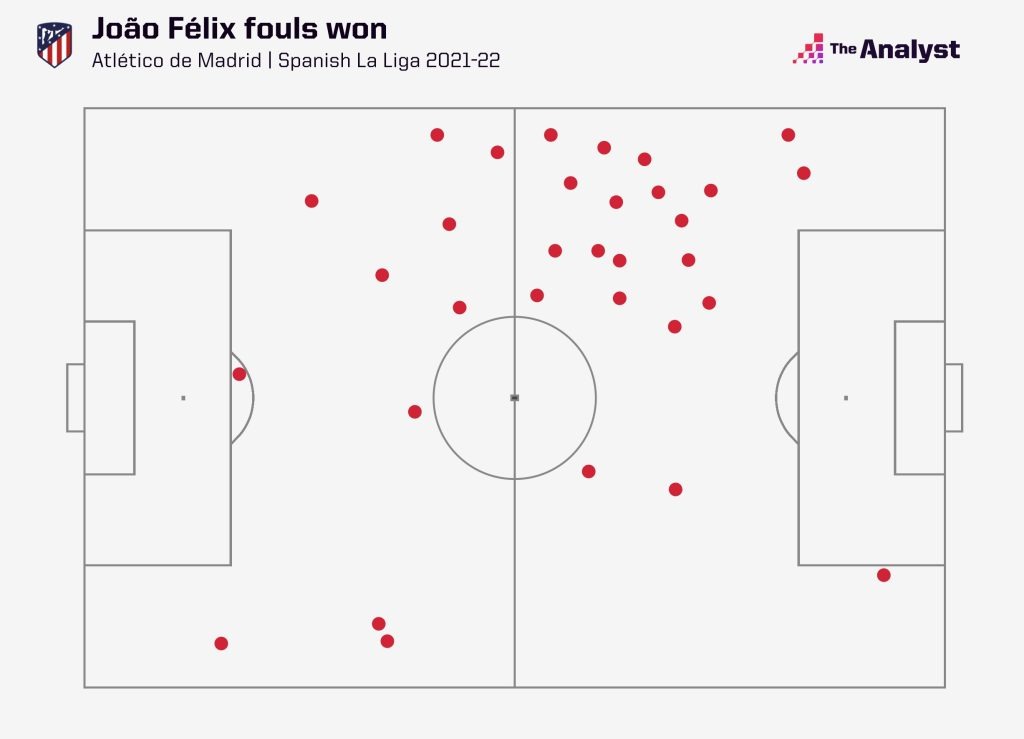
Of course, anyone who gets fouled to this degree is also skilled in the art of buying them. But while Félix uses deeper movements into the left channel to receive the ball, the reaction of opponents who snap onto him is instructive of the threat they perceive. Even when closer to the halfway line than the penalty area, the Portuguese often gets stopped in his tracks illegally before he can begin to make his next move or set off on a dribble. Indeed, Félix still ranks in the top 10 players in La Liga this season for successful take-ons per 90 (2.9), among those with 500 minutes played.
It’s these actions on the ball that differentiate Félix from every other attacking player Simeone has had at Atlético. Without being the outright-best in any category, the 22-year-old is a legitimate asset across the board as a scorer, creator, ball carrier and a conductor of play in the build-up. Many forward players have been more adept at a number of those things during Simeone’s tenure, but not all have ticked as many boxes. Félix’s main shortfall in this particular context, meanwhile, is that he doesn’t meet his manager’s standards without the ball, and so the tug of war between Simeone’s demands and the room to explore Félix’s talent is destined to persist.
In Atlético’s current setup, Félix is capped by certain constraints on a team level. Using their combined non-penalty xG and xA data in La Liga this season, note how the performance of Atlético’s forward players with 500+ minutes played are all within a small window. All four hover around the same 0.5 mark, while Félix’s numbers are almost identical to Griezmann’s. Given the rigidity of their approach, there is little room for divergence in players taking off on an individual level, compared to rivals like Real Madrid who have defined attacking leaders in Karim Benzema and Vinícius Júnior, and controlled service through their midfield.
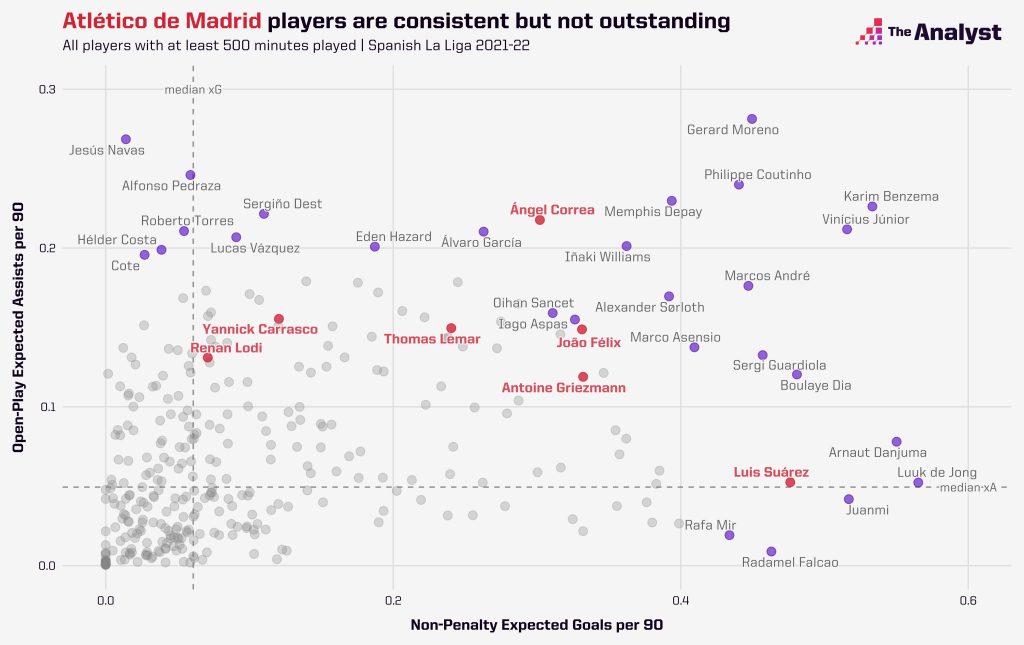
Though it might make sense for Atlético to have a wider pool of contributors and fewer individual drivers, it’s not conducive to exploring the depth of Félix’s talent – the investment that cost €126 million in transfer fee alone. For a player with such a unique level of on-ball talent, it begs the question of what he could achieve playing more of his football in the final third, with a team that support that attacking continuity on a structural level and at the same time minimise time spent without the ball. There’s a reason why Barcelona have never been far away from Félix’s name, as well as Manchester City via recent reports on his agent Jorge Mendes.
The 22-year-old is not entirely a victim of Simeone’s beliefs, of course. His effort levels fluctuate, he offers little out of possession, he lacks physicality in his play and his attitude can be questioned. But it wasn’t always this way – Félix arrived with the best intentions, and you could see the enthusiasm jumping off the screen in his early days at the club. After two-and-a-half years, it’s starting to look like that might have been lost for good at the club. Félix now cuts the figure of a player who knows time is elapsing in his anticipated career, in an environment where the limits of his potential torment him from the horizon.
On 22nd January in a game at home to Valencia, Félix sent a curved pass from deep with the outside of his foot to generate Atlético’s best opening of the game. It was the 55th minute and they were trailing 2-0, in dire need of all the inspiration they could get. Félix was substituted two minutes later, leaving the pitch on the far side and taking the long route back to the bench accompanied by a deluge of whistles from fans irked by his removal. If Atlético didn’t need him then, it begged the question of when they would.
When half an hour later they had completed an improbable turnaround to win 3-2, the details mattered. Atlético had taken off Félix and Thomas Lemar in the 58th minute – their two most creative attacking players – resorted to their classic 4-4-2 style and won the game through a smothering direct approach that was propelled by the sheer force of will that Simeone has forged in the club over the last decade. “Much fewer passes, but much more definite,” he later explained of their second half.
It was difficult not to wonder where it all left Félix; the club’s ultimate investment, whose growth depends on a contrasting football approach to that which had saved face for Atlético on the night. When asked after the final whistle how much football his side are capable of, given the nature of their turnaround, Simeone replied with questions of his own: “What’s football? What’s to play well?”
You’d have to think João Félix would have a different answer.
Enjoy this? Subscribe to our mailing list to receive exclusive weekly content.
